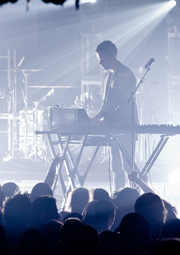The Joy of Live Shows: A Look into Great Concerts and Festivals
There’s an energy in the air at live shows that’s hard to describe. The anticipation as the crowd waits, the collective cheer when the first note plays, and the shared emotions as everyone gets lost in the music. Live shows, whether they’re massive festivals or cozy concerts, have a unique way of bringing people together.
They capture moments of pure joy, nostalgia, and connection, turning ordinary evenings into unforgettable memories. Dive with us into the world of live music and discover what makes these experiences so special.
The Immersive Experience
There’s an undeniable magic when lights dim, a hush falls over the crowd, and the first notes of a song reverberate through a venue. Whether it’s the electrifying atmosphere of a packed stadium or the intimate setting of a local bar, live music has the power to transport us to a different world.
From the raw emotions evoked by melodies to the shared camaraderie among fans, the experience of attending live shows is unparalleled. Let’s delve deeper into the multifaceted allure of live music.
The Emotional Resonance
The power of live music to stir our emotions is undeniable. Just like using a piano learning app can help us understand the intricacies of each note, attending a live performance brings us closer to the heart of the music.
Lyrics come alive, melodies resonate deeper, and an artist’s raw passion on stage can swing us from joy to deep thought. Whether it’s the poignant moment when a singer’s voice wavers with emotion, or the collective thrill as the audience joins in song, it’s times like these that remind us of our shared bond through the universal language of music.
Social and Cultural Significance
Concerts and festivals are more than just musical events; they are melting pots of social and cultural expression. In these gatherings, fans from various corners of the world, each with their own stories and backgrounds, come together, united by their mutual admiration for music. Such events offer a snapshot of contemporary cultural movements, capturing the zeitgeist of an era in their beats, lyrics, and atmospheres.
Over time, these musical gatherings have evolved into vital platforms for dialogue and expression. Think about iconic festivals like Woodstock in the ’60s, which became synonymous with peace movements and countercultural ideals. Or consider more recent concerts where artists champion causes, from climate change to social justice, turning the spotlight not just on their art but on pressing global issues.
Memories and Nostalgia
For countless individuals, concerts stand as indelible markers, timestamps in the narrative of their existence. Many can journey back in their minds to the raw excitement of their first live gig during adolescent years—the palpable energy of the crowd, the distant silhouette of the artist, and the heart-thumping resonance of live music.
Others might reminisce about that magical festival during a summer break—the warm sun, laughter-filled air, spontaneous dances, and the chorus of voices singing along in perfect harmony. And then there are those nights spent with close-knit friends, nights defined by impromptu gigs, shared jokes, and melodies that became their anthems.
With each live music experience, a wealth of memories is created—of friendships, emotions, places, and fleeting moments. These memories add a profound depth to our personal stories, often taking us on a trip down memory lane. The allure of nostalgia is powerful; the chords of a specific song or the lyrics of a particular artist can instantly transport us back, reigniting emotions and vividly painting scenes from yesteryears in our minds.
In essence, concerts and festivals don’t just offer music; they gift us moments—ones that, over time, weave into the fabric of our personal histories, cherished and revisited time and again.
The Art of Performance
Beyond the music itself, live shows are a testament to an artist’s prowess and charisma on stage. The choreography, stage design, and interplay with the audience transform songs from mere tracks into memorable spectacles. It’s this visual and interactive aspect, the flair and flamboyance, that makes live music a holistic sensory experience.
The Future of Live Music
The world of live music, like many industries, stands at the cusp of a transformative era. Technological innovations, combined with shifts in global culture and unforeseen challenges, are molding the future contours of live musical events. Today, the thrill of attending a concert isn’t just confined to physical venues.
Virtual concerts, once a novel idea, have now become mainstream, granting audiences a unique experience right from the comfort of their homes. Platforms are now using augmented reality to curate shows that blend the physical and digital, offering attendees a multi-dimensional concert experience that was once the stuff of science fiction.
Beyond this, the soundscape itself is undergoing a revolution. Immersive audio technologies are allowing fans to experience music in 360 degrees, enveloping them in layers of sound and offering a depth previously unattainable. Artists and event organizers are also exploring interactive concerts where the audience, through apps and other digital tools, can influence the course of the performance in real-time.
Yet, while the methods and mediums may change, the heart of live music—the communal joy, the shared emotions, the collective energy—remains untouched. As we look to the future, one thing is clear: live music will continue to be a cherished human experience, even as its form and format evolve. The fusion of tradition with innovation promises a vibrant, dynamic, and ever-expanding world of musical experiences for generations to come.
Final thoughts
Live music, with its vibrancy and immediacy, remains a celebration of art, culture, and human connection. Whether it’s the palpable energy in the air, the communal joy of singing along, or the memories created, concerts and festivals offer more than just entertainment—they provide moments of escape, reflection, and unity.
Yet, while the methods and mediums may change, the heart of live music—the communal joy, the shared emotions, the collective energy—remains untouched. As we look to the future, one thing is clear: live music will continue to be a cherished human experience, even as its form and format evolve. The fusion of tradition with innovation promises a vibrant, dynamic, and ever-expanding world of musical experiences for generations to come.









